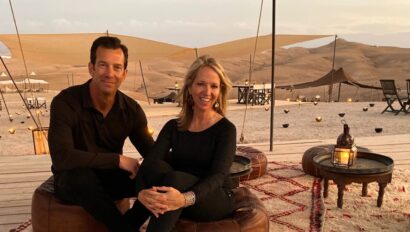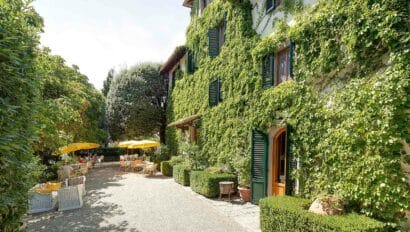When I moved to Kathmandu three years ago, I was instantly charmed by how every local I met greeted me with “Namaste.” You may know the word from yoga class, but in Nepal you’ll hear it on the street, on a trail, entering a restaurant, anywhere and everywhere. When a tiny kiddo says it to you and puts her little hands together with fingers pointed up as in prayer, well, what can you do but smile and return the blessing.
As I’ve discovered, it really is a blessing to be in Nepal. You should know right away though that you don’t have to trek! Everything that word implies—rugged hikes, thin oxygen, wind-whipped tents— leaves a lot of us cold. Luckily, there’s a kinder, gentler Nepal. It’s a place where farmers wade in terraced rice paddies that wrap around hillsides like emerald stairsteps. It’s a jungle where one-horned rhinos munch shoulder-high grass, oblivious to the Himalayas that feed their river. It’s pink rock salt in the bazaar of Kathmandu, grandmothers making their prayer rounds at the stupas, and momo dumplings with a chaser of tea.
It’s almost impossible not to have a spiritual moment when you watch the rising sun strike the tip-top of the Annapurna Himalayas…and then morph the snowy peaks from violet to gold. But don’t imagine for a second that everything will be only contemplative and ethereal on this new trip curated by Classic Journeys.You’ll see the Nepal I’ve happily adopted as my own:an active place, full of chances to meet the Nepalese people, walk in beautiful valleys,go on a rhino safari in Chitwan National Park and explore thickets of ornate temples in Kathmandu and Bhaktapur.
Your local Nepali guide won’t be content until you see and grasp the national character. That includes many moments when you’ll meet and interact with the people. On a trail through the Eastern Valley from Changu Narayan Temple, the locals won’t be shy about saying hello. Ask a farmer about his dzo(half yak/half cow)and you’re likely to get a full report, translated by your guide. Another day, you’ll be invited into a small village school to chat with the(very happy-to-see-you) students and their teachers. In Chitwan National Park,the indigenous Tharu people open their mud and bamboo huts so that you can see their way of life.
Of course, Chitwan is also the site of some of the best wildlife experiences anywhere in Asia.This 3,000-square-kilometer reserve is home to the endangered one-horned rhinoceros, which you’ll have a chance to spot on a safari led by expert naturalists. One cool option is to climb atop an observation platform that sways a little like the branches at the top of a tree.There are barking deer and peacocks and crocodiles as well, as you’ll see on a canoe safari. And mahouts will introduce you to their elephants and invite you to bathe them in the river.
About as far from an Everest tent camp as you could get,your accommodations are luxury inns and hotels, including a wonderful lodge in Chitwan with a viewing and dining deck that extends right over the Rapti river. Whether you’re trying street food, picnicking with a view of the Himalayas or dining in fine restaurants, you’ll enjoy the best of traditional Nepalese dishes. One evening, a local chef will even invite you into the kitchen so that you can cook together.
Practice your “namaste” now because I promise you it will come in very handy! The Nepalis are wonderful hosts who will respond gracefully to your curiosity. In my experience, they really will move mountains—pun totally intended—to make you feel welcome.




